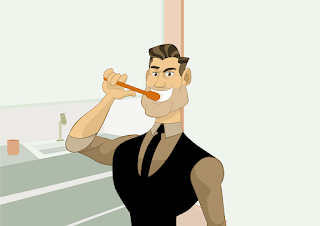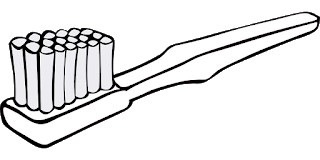
Brushing your teeth is not just for a whiter smile and fresher breath, it's critical for your overall health. Brushing teeth properly helps prevent cavities, and periodontal, or gum disease, which causes at least one-third of adult tooth loss. If teeth are not brushed correctly and frequently, it could lead to the calcification of saliva minerals, forming tartar. Tartar hardens if not removed every 24 hours. Poor dental health has been associated with heart disease and shortened life expectancy.
You know why to brush, but if you would like to learn how to brush your teeth efficiently, these suggestions will help.
Use a good toothbrush. Choose a toothbrush with soft nylon bristles. This must effectively remove plaque and debris from your teeth, without irritating the gums or eroding tooth enamel like hard-bristled brushes can do when used with sideways action. The toothbrush should also fit comfortably in your hand, and have a head small enough to easily reach all of your teeth, especially the ones at the back. If you have difficulty fitting the toothbrush into your mouth, it is probably too big.
Replace your toothbrush regularly. The bristles will wear out over time, losing their flexibility and effectiveness. You should purchase a new toothbrush every three to four months, or as soon as the bristles start to splay out and lose their shape. Visual inspection of the toothbrush is more important than the actual timeline. You can also buy toothbrushes whose handles will change colour when it's time to purchase a new toothbrush.
Use a fluoride toothpaste. It not only helps remove plaque, but it also helps strengthen tooth enamel. It is important to note that fluoride toothpaste is not to be swallowed, as ingesting too much can have serious health consequences. You can get toothpaste to target a wide variety of dental and gum problems, including cavities, tartar, sensitive teeth and gums, gingivitis and stained teeth. Opt for the one that suits your best or ask your dentist or hygienist for advice.
Remember to brush at least twice a day. Most dentists recommend that you brush at least twice a day - once in the morning and once before bed. If you can fit in a third time somewhere in the middle, even better!
Proper brushing technique
Use a small amount of toothpaste. Squeeze only a pea-sized amount of toothpaste onto your toothbrush. Applying too much toothpaste can cause over-sudsing, tempting you to spit and finish too early. Plus, it increases the risk of you ingesting more fluoride-filled toothpaste, which is very unhealthy.
Set your bristles at the gum line at a 45-degree angle. Gently brush with a short, vertical or circular motion. Don't brush across your teeth. Ask your dentist or hygienist to present you the correct brushing technique.
Spend at least three minutes brushing. Brushing just a few teeth at a time, work your way around your mouth in a circle so that you get every tooth, spending about 12 to 15 seconds in each spot. If it helps, you can divide your mouth into quadrants: top left, top right, bottom left, and bottom right. If you spend 30 seconds on each quadrant, you'll get a full two minutes of brushing time in.
Brush your molars. Position the toothbrush so that it's perpendicular to your lips, or so that the bristles are resting on top of your bottom molars. Work the toothbrush in an in-and-out motion, and move from the back of your mouth to the front. Then complete this motion doing s rotational movement of the brush in order to eliminate bacteria which have been dislocated from the surface. Repeat on the other side of your mouth. When the bottom teeth are clean, flip the toothbrush over and work on the top molars.
Brush the inner surfaces of your teeth. Tip the toothbrush so that the head of the toothbrush is pointing towards your gum line, and brush each tooth. Dentists report that the most commonly skipped area is the inside of the lower front teeth, so be sure not to forget those! Check that your mouth is opening wide enough by holding teeth apart with two or three fingers of your other hand. This will allow thecorrect vertical angle to reach theedge of gum.
Gently brush your tongue. After you've cleaned your teeth, use the bristles of your toothbrush to gently clean your tongue. (Don't press too hard, or you'll damage the tissue.) This helps keep bad breath away and gets rid of bacteria on your tongue.



Comment